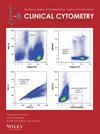Validation of a 12-color flow cytometry assay for acute myeloid leukemia minimal/measurable residual disease detection
Abstract
Background
Acute myeloid leukemia (AML) minimal/measurable residual disease (MRD) by multicolor flow cytometry is a complex laboratory developed test (LDT), challenging for implementation. We share our experience in the validation of a 12-color AML MRD flow cytometry assay to meet stringent regulatory requirements.
Methods
We worked under the guidelines of the CLSI HL62 publication, illustrated the details of the validation process that was tailored to uniqueness of AML MRD, and tested its clinical validity in 61 patients. The “trueness” was determined by correlating with concurrent molecular genetic testing and follow-up bone marrow examinations.
Results
Under assay specificity, we shared the details of panel design, analysis, and criteria for interpretation and reporting. The assay accuracy was assessed by testing known positive and negative samples and correlating with molecular genetic testing and follow-up bone marrow examination. The limit of detection (LOD) and limit of quantification (LOQ) were validated to a level between 0.01% and 0.1%, varied from the leukemia-associated immunophenotypes (LAIP) and the numbers of events obtained for analysis. Assay linearity, precision and carry over studies all met acceptable criteria. In the clinical validity test, the concordance was 93%, specificity 98% and sensitivity 83%. The most challenging aspects of the assay were the discrimination of pre-leukemic cells (persistent clonal hematopoiesis) or underlying myelodysplastic clones from AML MRD with immunophenotypic switch or subclone selection.
Conclusion
The validation met all criteria and obtained FDA IDE (investigational device exemption) approval. This study provides ample technical and professional details in setting up the AML MRD flow cytometry assay and illustrates through the example of the “fit for purpose” validation process. We also highlight the need for further characterization of abnormal blasts bearing the potential for AML relapse.

 求助内容:
求助内容: 应助结果提醒方式:
应助结果提醒方式:


